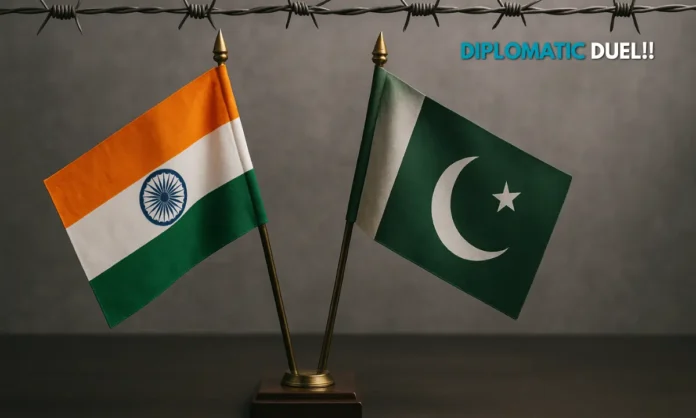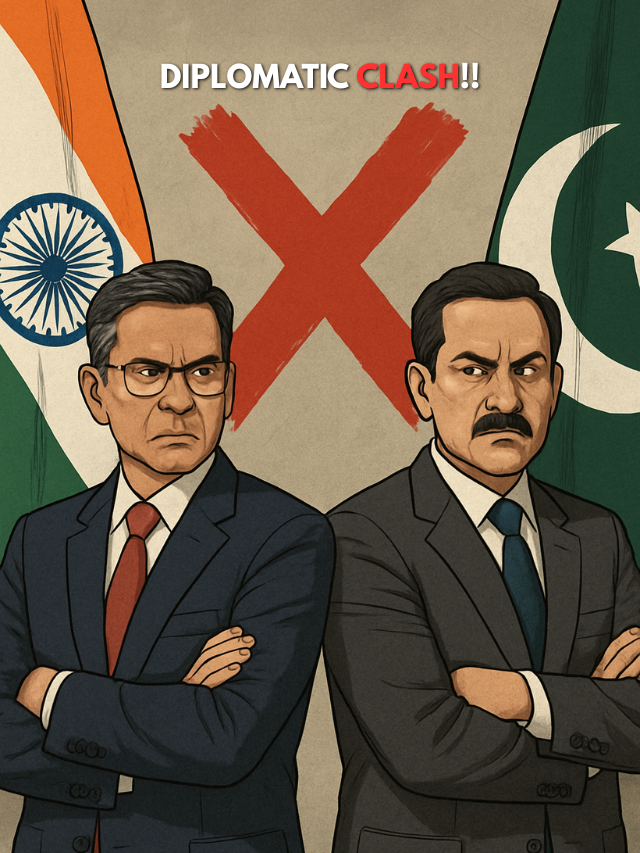Summary
- India and Pakistan expelled each other’s diplomats within 24 hours amid heightened post-Sindoor hostilities.
- The mutual “persona non grata” declarations mark a new diplomatic low following recent military conflict.
- This tit-for-tat expulsion mirrors past standoffs and reflects deepening mistrust despite the temporary ceasefire.
From Missiles to Memos: Diplomacy in Retreat After Sindoor
What began with the fiery thunder of drones and missiles under Operation Sindoor is now continuing through the cold calculus of diplomatic expulsions. On May 16, India and Pakistan once again found themselves in a familiar tit-for-tat maneuver—expelling each other’s officials under the charge of “activities incompatible with diplomatic status.”
India was first to act, declaring a Pakistani official at the High Commission in New Delhi persona non grata, effectively asking him to leave the country within 24 hours. Barely a day later, Pakistan responded in kind, targeting an Indian High Commission staff member in Islamabad for removal under the same charge.
While these expulsions are standard fare in diplomatic crises, their timing reveals deeper fragility in the bilateral relationship post-Pahalgam and Sindoor. Military strikes may have halted, but trust—and dialogue—remain suspended.
Another brainless tit-for-tat move by Pakistan.
— Sonam Mahajan (@AsYouNotWish) May 13, 2025
India caught an undercover ISI operative working as a staffer at the Pakistan High Commission in New Delhi, so Islamabad followed suit and declared an Indian diplomat persona non grata, because why not.
What a banana republic. pic.twitter.com/MtvRnMwPyH
Persona Non Grata: Ritual Retaliation or New Red Line?
- India expelled a Pakistani official for “activities not in keeping with his official status.”
- Pakistan reciprocated immediately, accusing an Indian diplomat of “engaging in incompatible activities.”
- Both diplomats were given 24 hours to exit their respective postings.
- Formal demarches were issued in Delhi and Islamabad to convey the decisions.
Declaring a diplomat persona non grata is one of the sharpest tools in diplomatic signaling short of breaking ties. It communicates that bilateral trust has eroded to a point where even routine diplomatic engagement is no longer safe or viable.
These actions also escalate psychological pressure—forcing countries to reconsider the presence, role, and reach of their missions in hostile territory. This isn’t just about one official being sent home; it’s about signaling strategic intolerance.
That both countries acted within hours of each other also suggests a lack of intent to de-escalate diplomatically, even after a military ceasefire was brokered on May 10.
Operation Sindoor Fallout: From Battlefield to Embassy
- India’s Operation Sindoor was launched after the Pahalgam terror attack killed 26 civilians.
- Indian forces targeted nine terror sites in Pakistan and PoK; Pakistan responded with drone and missile attacks.
- India then escalated with precision strikes on radar and command centers deep in Pakistan.
- Diplomatic fallout includes downgraded military attaches and renewed espionage accusations.
Diplomatic expulsions rarely occur in isolation. They’re often the downstream effect of escalated military or intelligence activity. In this case, the persona non grata declarations come just days after India’s cross-border retaliation under Operation Sindoor.
The expelled Pakistani official in Delhi and his Indian counterpart in Islamabad are both suspected of being involved in intelligence gathering or “activities not aligned with their official cover”—a common euphemism for espionage or subversion.
These moves also follow India’s earlier step in April to summon Pakistan’s top envoy and serve demarches post-Pahalgam. Then too, India expelled Pakistan’s top military advisers. The latest round reopens those wounds, just when both countries were supposedly inching toward stabilization.
A Familiar Pattern with Rising Stakes
- Similar expulsions occurred in 2016, 2019, and 2020 during past India-Pakistan standoffs.
- Each round of expulsions has historically coincided with military incidents or terror attacks.
- The current round is more concerning due to the nuclear undertone of Operation Sindoor.
- No backchannel peace process has yet emerged following this diplomatic rupture.
India and Pakistan have seen this script before. In 2016 after Uri, in 2019 after Pulwama and Balakot, and again in 2020, both countries resorted to declaring each other’s diplomats unwelcome. Yet, unlike previous incidents, this time it comes in the immediate aftermath of a high-intensity missile exchange—making this standoff feel more combustible.
The lack of a formal or even informal backchannel to absorb this diplomatic rupture is also troubling. Without track-II engagement or third-party mediation, mutual distrust festers. What begins as a tactical expulsion can morph into strategic disengagement.
With both sides now hardened in their rhetoric, the standoff risks becoming a long-term freeze in diplomatic operations—even as cross-border fire is halted.
Dialogue Deferred, Détente Dismantled
Diplomacy, at its best, absorbs shocks. But in the India-Pakistan context, it is often the first casualty. As both countries harden their positions—militarily on the LoC and diplomatically in the embassies—the potential for resolution shrinks.
The latest round of expulsions is not merely a bureaucratic gesture; it is a warning shot across the negotiating table. The message is clear: bilateral communication is not just stalled, it’s being dismantled, one diplomat at a time.



